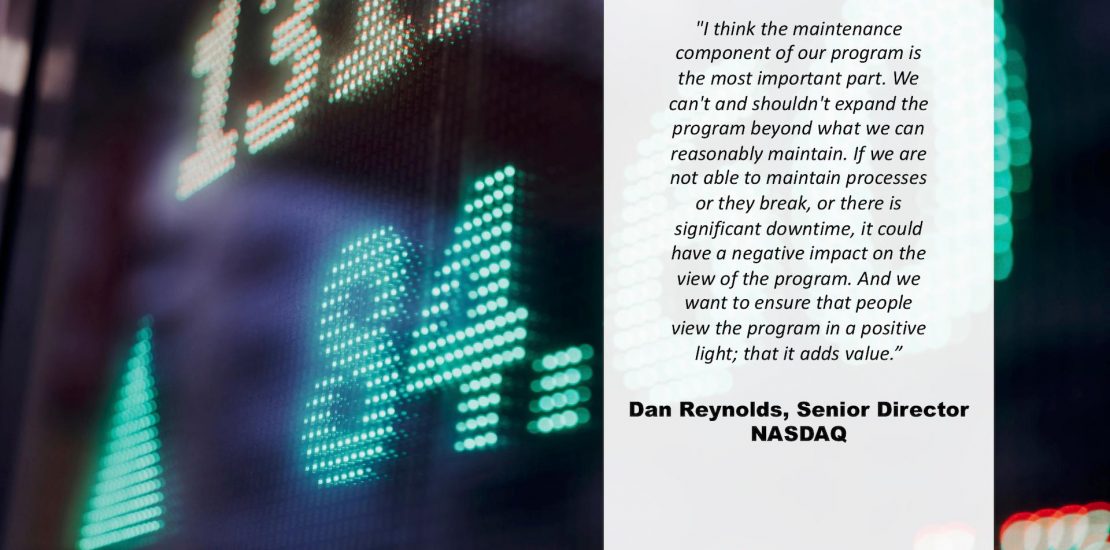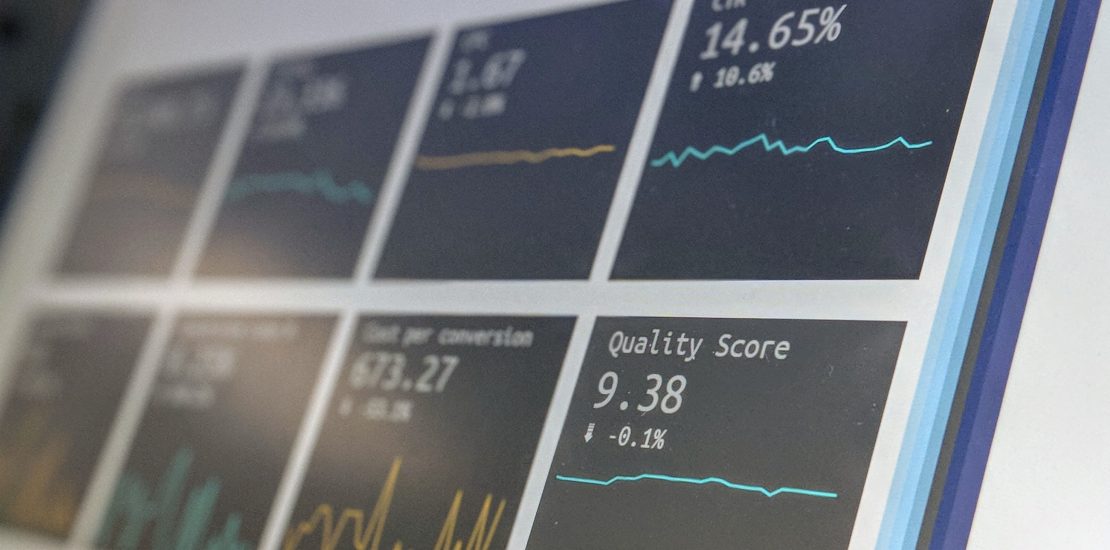Thought Leadership
Robotic Process Automation As A Service In Action: Nasdaq
June 16, 2021


Robotic Process Automation as a service, where businesses pay for robot usage rather than fixed licence costs, can be a real game changer for businesses. Through our partnership with Digital Workforce we are delighted to be bring our Robotic Process Automation as a service offering to APAC region. To help breakdown what this can look like for a business and the benefits it can deliver, we are sharing Nasdaq’s hugely successful RPA as a service partnership with Digital Workforce in the US.
Nasdaq leaps forward with RPA by building a scalable infrastructure and an inclusive engagement model
Nasdaq, an American stock exchange, began its RPA journey in the organisation’s Finance Department in 2018. Dan Reynolds, a Senior Director in the firm’s Corporate Finance Advisory Office, shared his experience of implementing RPA across Nasdaq’s finance operations. Dan’s team is responsible for managing Finance’s strategic initiatives relating to data analytics and automation, including the organisation’s RPA initiative.
Read Dan’s story of Nasdaq’s RPA journey below or listen to the full webinar here!
RPA as a service at Nasdaq
Nasdaq’s first steps: Building initial competence
As Dan testifies, getting started is often the hardest part.
RPA was considered for some time at Nasdaq and Dan knew there were strong use cases within the organisation. “We wanted to get something in production; wanted to automate a process,” he explains, “to see RPA in action as a proof of concept, demonstrate value and see if we thought it was something that we could roll out to the broader finance organisation and the organisation more generally.”
“We also wanted to build some internal competences within the team to get people trained so we could stand up a program internally. We had members of the team who had experience from related fields, but no one had direct experience with RPA. Everyone in our project team took the RPA Analyst course in Digital Workforce Academy. That was really important because it helped the team solidify their understanding of what RPA is and, maybe more importantly, what it isn’t – what it’s not meant for. It helped us figure out what makes a good process candidate for automation. Also, it really helped us establish what needs to go in it in terms of documentation: how do we need to document these processes to have them ready to be handed over to a developer?” Dan adds.
From the execution standpoint, setting up the right infrastructure was the most challenging part of Nasdaq’s pilot. “We wanted to set up our infrastructure in a way that was sustainable and ensure our robot could reach our target applications. We knew we wanted to leverage a managed service to outsource the management at the backend. We did an analysis and knew we didn’t want to stand up that infrastructure ourselves. But also making sure we could install the robots, get them to reach our target applications, and do all this in compliance with our various information security policies,” Dan says of the challenge that needed to be overcome. “For the future, we continue to leverage the managed service and appreciate the flexibility of being able to scale up quickly or dial back as needed.”
Spreading the message and engaging people
Dan and his team were very happy with the results of the two initial pilot processes and were excited about the possibilities across their organisation. Going forward, the team wanted to engage departments in candidate process identification.
Before involving more people, Dan’s team needed to formulate a solid governance model for RPA. “What turned our pilot into an actual program was establishing a governance framework. We formalised our automation lifecycle: what are the required documents necessary for each automation? How do we select a process, what approvals go into selecting a process? What approvals happen along the way? What’s required before you put something into production? All this has been established so we can make sure we’re executing with a consistent methodology for each automated process,” says Dan.
Nasdaq’s project team also identified 5 additional processes to transition into the pipeline to work on while simultaneously working with the different departments. The team started engaging people from the controllers’ organisation because of a natural overlap in processes and systems between these groups. “If we get a robot to connect to a certain target application, it should allow us to automate additional processes utilising the same system more quickly,” Dan reasons.
Dan’s team executed a roadshow to engage controllers within the finance organisation with the aim of identifying a member of each team who could become a designated analyst for the program. These people would act as a liaison between the program and the department. Dan’s RPA team gives the designated analysts training and an overview of the program’s governance, while the analysts bring to the table their knowledge about their team and its processes.
Dan’s team initially had mixed reactions from different departments; some were really excited to get going, but others were skeptical. Bringing out examples from the pilot was very helpful in selling the concept to different groups. Dan’s team would show their colleagues a video recording of what the automated process looked like and then show them the results. Dan reports, “The program has become very popular in the organisation. People are excited about the potential in their group.”
RPA isn’t a headcount reduction exercise at Nasdaq. Rather, it’s a tool that allows people to focus on more value-adding tasks. This approach to RPA has helped people view RPA as an opportunity, rather than a threat. At Nasdaq Finance, RPA enables people to do less data processing and more data analysis. When people show up at work in the morning, the data they need is ready and they can immediately start adding value by analysing it.
Dan’s team also received positive feedback about the training provided to the dedicated analysts within the different departments. All analysts have taken the Digital Workforce Academy RPA Business Analyst course, which serves as a baseline for Nasdaq’s RPA team. “We received good feedback from the departments on the course because there is a lot of practical exercises,” Dan explains, highlighting the value of learning by doing.
Selecting processes for automation and measuring success
In addition to having a scalable infrastructure in place, automation at Nasdaq is gaining speed due to building and prioritising the automation pipeline in an effective manner. “I think that in our program – as a best practice – we try to automate things that are in production already. We want to make sure that we have a mature process being performed in a manual state. We don’t want to automate a bad process because then we are in the business of doing bad processes faster,” Dan explains. He continues, “If a solution comes forward to our team for evaluation that is not an existing process, we really take a hard look at that as well. It’s not impossible to create something that is not in existence today, but it requires a ton of planning because when you automate something, you need to know where the potential exceptions are. You need to be able to teach the robot how to handle the different things that could pop up along the way. If it’s not an existing mature process, you may not know all those exceptions. Therefore, your automated solution could break or has a higher likelihood of breaking, requires more maintenance, requires more work from the project team… So generally, we try to find things that are mature as processes, just inefficiently performed manually.”
Dan’s team measures the benefit of Nasdaq’s automated processes by four metrics:
- Hours saved: when a task has previously been done manually but is now done by a robot.
- Hours avoided: when a task was being done less frequently than an ideal situation would allow, usually due to lack of available resources. Now, robots do it as often as needed. Here the team measures added value but keeps the measurement separate from hours saved.
- Hard dollar savings.
- Qualitative benefits: factors such as mitigated risk, compliance, employee morale, etc.
“In the fourth bucket, it’s a little harder to capture everything in a tangible way, but we measure it,” Dan says. “Our project team is getting really popular. People are getting excited about the prospect of shifting some of the really manual processes off their plate, so they can focus on other things and do more with our existing team structure.”
Scaling up and future vision
Dan and his team are formulating a sustainable model for RPA maintenance as they begin to scale up Nasdaq’s RPA program. “We are at a state right now where our developers can monitor our processes and fix them as they go. We have enough resources compared to the number of processes in production where it’s not a challenge yet. We know it’s not sustainable though and it needs to be a dedicated function because I don’t want to expand our program beyond what we can reasonably maintain,” Dan says. “Where we aspire to grow our program, we need to ensure there is a solid maintenance function to make sure that we have maximum uptime which will ultimately lead to success. You see it in our expansion criteria as well. We have agreed that we can’t expand unless these criteria are met – one of them being that maintenance can support the existing processes in production.”
He continues: “I think the maintenance component of our program is the most important part. We can’t and shouldn’t expand the program beyond what we can reasonably maintain. Ideally, I’d love to automate more and deliver value across the organisation and keep expanding our program, but we shouldn’t do so if we can’t sufficiently maintain the processes we already have in production. If we are not able to maintain processes or they break, or there is significant downtime, it could have a negative impact on the view of the program. And we want to ensure that people view the program in a positive light; that it adds value. It’s allowing them to have staff from these various departments freed up to work on more complex, more value-add activities. I don’t want people not coming to the program with process ideas because they have a negative view of the program; if they automate this, it’s just going to break, so it’s not a good use of our time to get it up and running,” Dan explains. This best practice approach will help to ensure that staff stay as enthusiastic about the RPA journey as they are today.
Dan sees many more opportunities for automation outside of Finance and across the whole organisation. He believes that growing the program both within Finance and outside of it could happen simultaneously. Aside from addressing RPA maintenance with a more sustainable model, Dan looks forward to incorporating more intelligent automation into the program.
Digital Workforce delivers Nasdaq RPA as a Service with support in development, mentoring, and training from Digital Workforce Academy.




